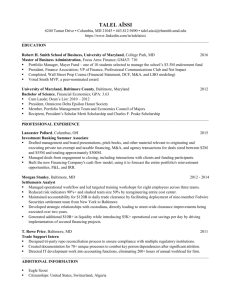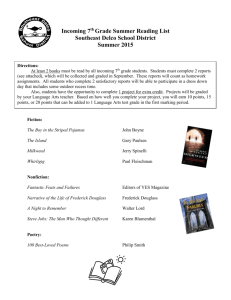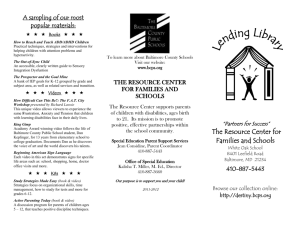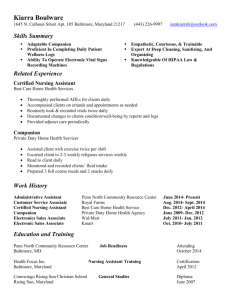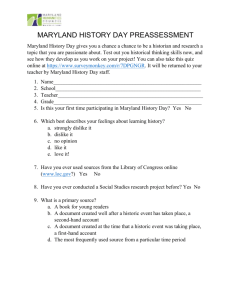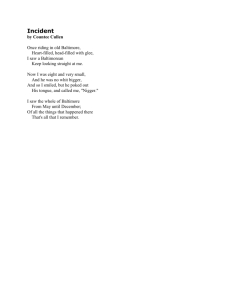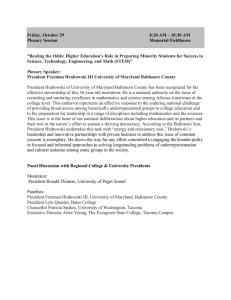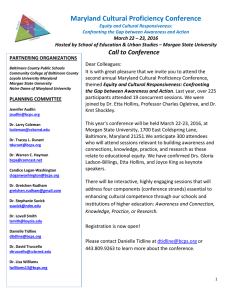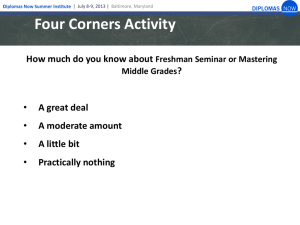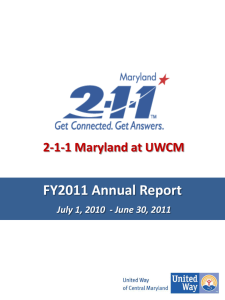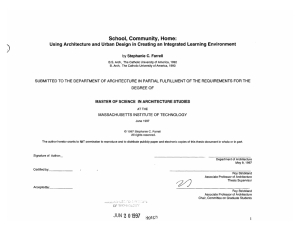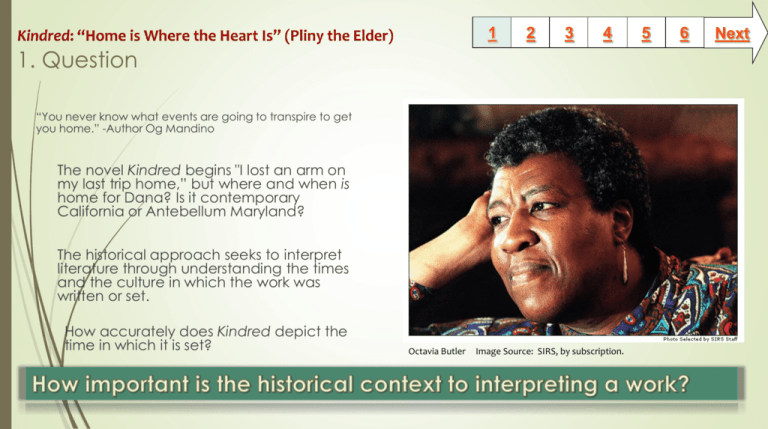
1
2
3
4
1. Question
“You never know what events are going to transpire to get
you home.” -Author Og Mandino
The novel Kindred begins "I lost an arm on
my last trip home,” but where and when is
home for Dana? Is it contemporary
California or Antebellum Maryland?
The historical approach seeks to interpret
literature through understanding the times
and the culture in which the work was
written or set.
How accurately does Kindred depict the
time in which it is set?
Octavia Butler
Image Source: SIRS, by subscription.
5
6
Next
2. Information Sources
1
General
Resources
•
•
•
•
•
•
•
•
Narrative of Lucy Brooks
•
(click “view page images”)
•
•
•
•
•
Narrative of Charles Coles
Narrative of Dennis Simms
L’Hermitage
Slave cabin image – St.
Mary’s County
Wye House Plantation
Harriet Tubman Overview
Underground Railroad
Overview
Runaway Laws
Virtual Tour
Runaway Images
Caroline Hammond’s story
Baltimore &
City Life
Agricultural
Life
•
3
4
5
6
Next
Underground
Railroad
&Tubman
Guide to the History of
Slavery in Maryland
Frederick Douglass Overview
Emancipation Proclamation
text
WPA-collected slave
narratives
•
•
2
•
•
•
•
Frederick Douglass in Baltimore
(focus on “His Early Life”)
Slave Jails in Baltimore
Kidnappings (see page 73)
Hampton Mansion in Baltimore
County
Sample Runaway Ad-Henry Smith
and Case Studies
Image Source: Maryland State Archives
Quakers &
Manumissions
•
•
•
Enslaved Women & 1809
Maryland Manumission Law
Sample Manumission 1, 2, 3
(Discovery Education, by
subscription)
John Woolman’s (Quaker)
Journal
3. Student Activity
1
2
3
4
5
6
Next
1. Divide into groups at your
teacher’s direction to
examine the topics on
slide 2.
2. Organize information on
the handout. Be sure to
record sources
appropriately.
3. With your group, create
a shared multimedia
presentation using Prezi,
PowerPoint, or Google
Drive (email account
required) to summarize
your findings.
The Bucktown Village Store in Dorchester County where Harriet Tubman worked as a young
woman. For more information, click here.
Image Source: Heather Jennings, BCPS teacher
4. Assessment Activity
1
2
3
4
5
6
Next
How important is the historical
context to interpreting a
work?
How accurately does Kindred
depict the time in which it is
set?
This ledger from
Captain Anthony
contains a
reference to
Frederick
Augustus, who
became Frederick
Douglass
Image Source:
Maryland State
Archives
Your response may be scored
using this rubric or by another
method as directed by your
teacher.
5. Enrichment Activities
1
2
3
4
5
6
What is home? Consider the news stories
of Saroo Munshi Khan or Luo Gang who
both used technology to discover their
birth places and families after unusual
separations.
Consider interviewing and recording
someone who left home or created a
new home through a situation such as
military deployment, adoption, foster
care or immigration.
Newly naturalized citizens hold up their right hands during a
naturalization ceremony held in the administrative building of the
Daughters of the American Revolution in Washington, D.C., on
March 27, 2006. U.S. President George W. Bush spoke during the
ceremony about his administration's stance on legal and illegal
immigration.
Image Source: Opposing Viewpoints in Context, by subscription
Where is home?
How did his or her understanding of home
change?
Next
6. Teacher Support Materials
1
2
3
4
5
6
English 9, Unit 1 PBA2
ISTE NETS - National Educational Technology Standards for Students
Common Core State Standards
3. Research and Information Fluency: Students apply digital tools to
gather, evaluate, and use information.
b. Locate, organize, analyze, evaluate, synthesize, and ethically
use information from a variety of sources and media.
Reading: 1. Read closely to determine what the text says explicitly and to make logical
inferences from it; cite specific textual evidence when writing or speaking to support
conclusions drawn from the text.
Reading: 7. Analyze various accounts of a subject told in different mediums (e.g., a person's
life story in both print and multimedia), determining which details are emphasized in each
account.
Reading: 9. Analyze seminal U.S. documents of historical and literary significance, including
how they address related themes and concepts
Speaking & Listening: 1. Initiate and participate effectively in a range of collaborative
discussions (one-on-one, in groups, and teacher-led) with diverse partners on grades 9-10
topics, texts, and issues, building on others' ideas and expressing their own clearly and
persuasively.
Writing: 7. Conduct short as well as more sustained research projects based on focused
questions, demonstrating understanding of the subject under investigation.
Writing: 10. Write routinely over extended time frames (time for reflection and revision) and
shorter time frames (a single sitting or a day or two) for a range of discipline-specific tasks,
purposes, and audiences.
Standards for the 21st Century Learner
1.1.6 Read, view, and listen for information presented in any format (e.g. textual, visual,
media, digital) in order to make inferences and gather meaning.
2.1.3 Use strategies to draw conclusions from information and apply knowledge to
curricular areas, real-world situations, and further investigations.
4. Critical Thinking, Problem Solving, and Decision Making: Students use
critical thinking skills to plan and conduct research, manage
projects, solve problems, and make informed decisions using
appropriate digital tools and resources. c. Collect and analyze
data to identify solutions and/or make informed decisions.
Time Frame: one-two 90-minute class periods (one for information
gathering and another for sharing)
Differentiation strategies for this lesson:
Direct students to use learning tools included in our BCPS-licensed
databases, such as: audio read-aloud, labeled reading
levels/Lexiles, and embedded dictionaries.
indicates more challenging reading material with a higher Lexile
Learning Styles addressed in this lesson:
Field independent, field independent, global, visual, tactile
Notes to the teacher:
Collaborate with your school library media specialist to implement
this lesson.
Last updated: July 2015
Created by Heather Jennings, STAT teacher
BCPS Slam Dunk Research Model, Copyright 2013, Baltimore County Public Schools, MD, all rights reserved. The models may be used for educational, non-profit school use only.
All other uses, transmissions, and duplications are prohibited unless permission is granted expressly. This lesson is based on Jamie McKenzie’s Slam Dunk Lesson module.

